The interaction between human beings and grassland ecosystems: conservation and environmental education of rural grassland landscapes
12.10.2023
SUBMITTING ORGANIZATION
Soil and Water Conservation Bureau, Council of Agriculture Executive Yuan, R.O.C.(Chinese Taipei)
OTHER CONTRIBUTING ORGANIZATIONS
National Chung Hsing University, R.O.C. (Chinese Taipei)
Taiwan Landscape Environment Association, R.O.C. (Chinese Taipei)
Taiwan Forestry Research Institute, R.O.C. (Chinese Taipei)
Hsinchu Forest District Office, R.O.C. (Chinese Taipei)
Taiwan Endemic Species Research Institute, R.O.C. (Chinese Taipei)
DATE OF SUBMISSION
29/06/2023
REGION
Asia
COUNTRY
Chinese Taipei
KEYWORDS
Taiwan; environmental education; rural development; grassland conservation; rare plant conservation
AUTHORS and AFFILIATIONS
Chen Yang Lee1, Ci-Fang Ciou2, Chen-Fa Wu3*, Ling-Tsen Chen1, Chen-Jung Liu2, Szu-Hung Chen4*, Hao-Yun Chuang1, Hsi-Chun Chen2, Wei-Hsun Chang3, Chun-Hsien Lai5, Hao-Wei Hsu5, Huan-Yu Lin6, Chien-Fan Chen6, Luu Van Thong Trac3*, Da-Li Lin7, Jn-Guo Cho5
- Soil and Water Conservation Bureau, No. 6, Guanghua Road, Nantou City 540, R.O.C. (Chinese Taipei)
- Taichung Branch Soil and Water Conservation Bureau, No. 22, Yangming Street, Fengyuan District, Taichung City 420, R.O.C. (Chinese Taipei)
- Department of Horticulture, National Chung Hsing University, No. 145, Xingda Road, South District, Taichung City 402, R.O.C. (Chinese Taipei)
- International Master Program of Agriculture, National Chung Hsing University, No. 145, Xingda Road, South District, Taichung City 402, R.O.C. (Chinese Taipei)
- Taiwan Landscape Environment Association, 10F, No. 118, Mingcheng 2nd Road, Sanmin District, Kaohsiung City 80794, R.O.C. (Chinese Taipei)
- Taiwan Forestry Research Institute, No. 53, Nanhai Road, Zhongzheng District, Taipei City, 10066, R.O.C. (Chinese Taipei)
- Taiwan Endemic Species Research Institute, No 1, Minsheng E Rd, Jiji Township, Nantou County 552203, R.O.C. (Chinese Taipei)
Summary Sheet
The summary sheet for this case study is available here.
Summary
In Taiwan, a subtropical island with high mountainous ranges, the boasts grassland landscapes are only found on the coastal hillsides of Miaoli County. These landscapes are the important hotspots for the rare and endangered plant species of Taiwan and with significant ecosystem functions. However, the grasslands are often intertwined with farmlands and residential spaces, and suffer from serious local disturbance such as burning weeds as a traditional culture during tomb sweeping season. Some plant species have evolved some morphological adaptations for against fire disturbance. To protect the endangered ecosystem, the Soil and Water Conservation Bureau (SWCB) has conducted ecological impact assessments and has promoted the eco-friendly construction methods to minimize the impact of development on the grassland landscapes. In addition, the Sinpu community and Sinpu Elementary School attended environmental education training workshops which were designed by the SWCB. The Taiwan Forestry Research Institute has provided seedlings for conserving the rare and endangered plants on the campus. Furthermore, the local community has developed environmental education programs that focus on the rare plant conservation and the preservation of traditional languages. These actions will sustainably conserve the unique and valuable grassland landscape of Miaoli County.
Background of Sinpu Community
1. Natural environment and land use
The Sinpu Community is situated in the Tongxiao Township of Miaoli County, comprising an area of 302 hectares and accommodating a population of around 1100 individuals. The topography of the region features hillsides, plains, and ocean from the east to the west, and the area is abundant with trees and cooled by the coastal breeze. The subtropical climate of Sinpu Community manifests with an average annual temperature of approximately 22 degrees Celsius, with an annual maximum temperature of 26 degrees Celsius and an annual minimum temperature of 19.4 degrees Celsius. The locality is subject to the influence of both the southwest and northeast monsoons, with the latter leading to an average wind speed of 5.5 m/s in December. The southwest monsoon dominates the area between early May to late September, occasionally bringing about strong winds along the coast. The months between July and October typically experience the most intense typhoons, leading to the breaking of tree branches and the falling of grass on hillsides. Finally, the relative humidity is most affected during the rainy season, with the winter and summer periods experiencing an average of 82% and 80%, respectively (CWB Observation Data Inquire System, 2021).

The Sinpu Community is situated in the Tongxiao Township of Miaoli County, comprising an area of 302 hectares and accommodating a population of around 1100 individuals. The topography of the region features hillsides, plains, and ocean from the east to the west, and the area is abundant with trees and cooled by the coastal breeze. The subtropical climate of Sinpu Community manifests with an average annual temperature of approximately 22 degrees Celsius, with an annual maximum temperature of 26 degrees Celsius and an annual minimum temperature of 19.4 degrees Celsius. The locality is subject to the influence of both the southwest and northeast monsoons, with the latter leading to an average wind speed of 5.5 m/s in December. The southwest monsoon dominates the area between early May to late September, occasionally bringing about strong winds along the coast. The months between July and October typically experience the most intense typhoons, leading to the breaking of tree branches and the falling of grass on hillsides. Finally, the relative humidity is most affected during the rainy season, with the winter and summer periods experiencing an average of 82% and 80%, respectively (CWB Observation Data Inquire System, 2021).

2. The Sinpu grassland ecosystems
Taiwan is the home to approximately 5,000 native vascular plant species, of which 989 have been classified as “threatened” in the “Red List of Vascular Plants of Taiwan”. To gain insight into the distribution of rare plants, survey data accumulated over time were utilized to create a hotspot map identifying the distribution of threatened species within the jurisdiction. The map, with a resolution of 5 kilometers, highlights 297 species identified in the regions of Taoyuan, Hsinchu, and Miaoli. Notably, the state-owned forest areas located in the hills surrounding Miaoli City, from Zhubei to Xinfeng, and from Houlong to the coast, serve as primary hotspots (Taiwan Forestry Research Institute, 2022).

Five types of grasslands in Taiwan (Observer Ecological Consultant Co., Ltd., 2022):
- Grassland and shrubs are found within various alpine vegetation belts, while fir, hemlock, and oak forest belts tend to dominate middle and high elevation ranges. However, environmental pressures have resulted in a significant period where herb, shrub, and arrow bamboo-dominated vegetation has persisted within the grassland and shrub ecosystems.
- Low-elevation mountainous grasslands and shrubs tend to persist in such areas for extended periods due to environmental pressures, such as periodic fires and strong winds. The grasslands consist primarily of closely related herbs and shrubs, with the majority of species being low bamboos that typically do not exceed 5 meters in height.
- Grasslands and shrubs are also present within alluvial valley terrain and vast plains that stretch from mountain streams to the top of alluvial fans. Due to its accessibility, these areas have been frequently utilized by humans and subsequently abandoned, leaving behind unclear boundaries between human and non-human usages. The vegetation within these areas typically consists of local grasses or meager woody species and can incorporate some or all existing types of unique grasses. These types of grasslands and shrubs are often found in close proximity to built-up structures, open green spaces in urban areas, and agricultural land.
- The substrate consists of sand, gravel, reef rock, or other stony soils that closely resemble the physical and chemical properties of the parent rock. This soil type is prevalent in salt-tolerant plants, grasslands, and shrubs near the sea.
- Vegetation engineering of landslides has successfully introduced certain grasslands and shrubs into appropriate locations. The treatment methods and time required for plant growth may vary greatly. Bermuda grass, ryegrass, tall fescue, and woody plants are often hydro seeded or planted vegetatively, respectively.
The shrubs and grasslands of the Sinpu community form part of the low-elevation grasslands found in mountainous regions. Four primary factors influence their development. First, they are situated at the intersection of mountains and the coast, where strong offshore winds are common. Second, winter precipitation is scarce due to the northeast monsoon climate. Third, the ignition of fires by humans, which can occur through various activities such as farming practices involving the burning of straw or crop residues, as well as the traditional practice of tomb sweeping during the Qingming Festival involving the burning of joss paper, significantly contributes to the spread of wildfires. This recurring occurrence poses a significant obstacle to the establishment and growth of forested areas, presenting considerable challenges for forest regeneration and development. Fourth, the loess in the area has low acidity and low organic matter content, making it unsuitable for plant and crop growth. The long-term stability of the grassland is largely due to environmental forces such as fire, strong winds, and soil. The abundance of native grass species makes it easier to find rare plants in this area (Observer Eco-Consulting Ltd., 2022).
Description of human-nature interactions in the area
1. Ecological services of the Sinpu grassland ecosystem
The grassland ecosystem is composed of drought-tolerant herbaceous, shrub, and plant species with a maximum height of 5 meters. However, due to environmental constraints such as topography, soil, wind, climate, grazing, and burning, the development of forest-like structures is limited. Nonetheless, the formation of this ecosystem provides numerous vital ecosystem services.
Firstly, it serves as a water source conservation system. The research area is located in a conservation area on a mountain slope where the undisturbed original vegetation has a significant water source conservation effect. There are 18 natural springs located at the interface between the coast and residential areas. Investigation results show that the water temperature ranges from 22.98 to 30.58℃, conductivity ranges from 0.200 to 0.466 ms/cm, total solids concentration ranges from 0.134 to 0.293 g/L, salinity ranges from 0.10 to 0.22%, percent dissolved oxygen ranges from 10.0 to 70.7%, actual dissolved oxygen ranges from 0.79 to 5.32 mg/L, pH ranges from 7.41 to 7.91, and oxidation-reduction potential ranges from 105.8 to 182.8. Overall, except for one spring with moderate pollution, the rest was either uncontaminated or mildly polluted.
Secondly, the grassland ecosystem plays a significant role in soil and plant carbon sequestration. Grassland plants fix carbon through their body and roots, and this carbon is stored in the soil after burning. This process occurs every 2-3 years, contributing to the formation of an efficient carbon sequestration system.
Thirdly, the grassland ecosystem has excellent soil and water conservation functions. Dense grass growth on slopes prevents soil erosion caused by heavy rains brought by the northeast and southwest monsoons and summer typhoons, maintaining the landscape of the slope.
Fourthly, the grassland ecosystem serves as a livestock-raising site. For a long time, residents have used this grassland for raising a small number of cattle, mainly for assisting in cultivation.
Fifthly, the grassland ecosystem still produces some crops, such as sweet potato and peanuts, and the 1-2-meter-tall grasses serve as the best shelter against strong winds for farmland cultivation.
Sixthly, the grassland ecosystem provides educational, cultural, and leisure services. Many endemic plant species in Taiwan grow in the grassland area of the research site, making it an essential area for species conservation, environmental education, and recreational tourism. In addition, the Lin-Tou Earth God Temple located on the top of the grassland is an important religious center for residents. Lastly, the grassland ecosystem provides important habitats for small mammals (rodents and rabbits), snakes, and raptors.
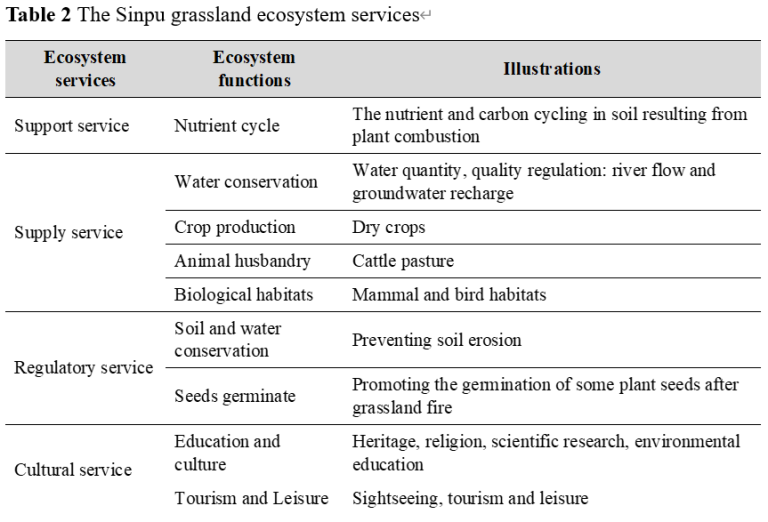

2. The rare and valuable plants of grassland landscape
Based on the data from the investigation project of the native grassland ecosystem and the biodiversity mapping database in the Houlung River, there are a total of 9 species from 6 families of ferns, 110 species from 44 families of dicotyledonous plants, and 27 species from 10 families of monocotyledonous plants, indicating a high plant diversity with a total of 146 species from 60 families.

The grassland landscape within the Sinpu community plays a crucial role as a habitat for endangered plant species. According to the 2017 edition of “The Red List of Vascular Plants of Taiwan”, Sinpu community is home to a significant number of threatened taxa. Specifically, this includes five critically endangered (CR), ten endangered (EN), six vulnerable (VU), and one near threatened (NT) taxa. A summary of the recorded plant species can be found in the following table.
Forest fire, also known as forest fire disturbance, affects changes in forest ecosystems, resulting in a decrease in flora, fauna, and microorganisms, as well as changes in environmental factors such as soil properties, temperature, humidity, and light, which in turn affect plant regeneration. According to the information system of the Forest Fire Potential Index (https://forecast.forest.gov.tw/forecast), 98.06% of forest fires are caused by human activities, including negligence in fire handling, smoking, arson, grave sweeping, hunting, camping, and land clearing. The sloping terrain in the Sinpu community of Miaoli County is a high-risk area for forest fires. This study conducted interviews with residents and collected reports on the impact of human-caused forest fires on the shallow mountain plants in Miaoli from FTV News, the Forest Fire Potential Index Information System, and research studies. Recorded incidents of the Tongxiao Sinpu Lingding Fire were discovered, which occurred in February of 2013 due to grave sweeping, in October of 2018 due to spontaneous combustion in the summer, and in March of 2021 again due to grave sweeping. The main reason for the fire was the abundant withered grass during the winter season, which became a good fuel for burning. During the Qingming Festival in March and April, people tend to use fire to clear the weeds, which led to large-scale grassland fires after spreading (Forest Fire Disaster Potential Database Information System, 2023).

Rational
Risk assessment of plant habitats
Out of 344 habitats evaluated, 109 were assessed to be of high and medium-high risk, encompassing 66 threatened species. Private croplands, abandoned grasslands, and low-elevation graveyards constituted the majority of high-risk habitats. Notably, the only privately-owned open grassland located in Sinpu, Maioli County, was identified as a high-risk habitat. This open grassland is distinguished by having the highest richness of threatened species in Taiwan, with more than 20 threatened species observed within its 6-hectare area.

Activities and/or practices employed
1. Taiwan promotes national green network and eco-ark project
The Hsinchu Forest District Office initiated the Land Ecological Conservation Green Network Construction Plan in 2017. The first phase of the plan involved a comprehensive inventory of natural environment characteristics, biodiversity hotspots, and sensitive locations in northwestern Taiwan. The second phase aims to create a biosafety network by incorporating the “Forest-River-Land-Sea” corridor and conserving Taiwan’s first categories of protected wild animals, including the Leopard cat (Prionailurus bengalensis), Taiwan gudgeon (Squalidus iijimae), and grassland rare plants. The construction of the “Conservation Axis of Houlong River and Miaonan Shallow Mountains and Hills” is a priority during this phase.
During 2018-2020, the Hsinchu Forest District Office compiled a list of 410 species of concern and their habitat preferences in northwestern Taiwan. From this list, the Office identified more than 250 coastal areas, pond environments, and grassland environments, and shortlisted 72 species that urgently require conservation. Five major issues were identified, including “Rare Grassland Plant Conservation”, “Friendly Shallow Mountain Pond”, “Friendly Shallow Mountain Forest”, “Construction of Friendly Ecological Vegetation in Houlong River Corridor”, and “Friendly Stream Governance”. Four high-potential value key promotion areas were also selected to improve degraded habitats and enhance habitat connections.
The Hsinchu Forest District Office aims to establish the first out-of-region restoration and conservation base for rare grassland plants in northwestern Taiwan in the Yue Tao Ping District of the Houlong Cape of Good Hope. The preservation of rare plant provenance, such as Hairystyle Cherry (Prunus pogonostyla, VU), Sichuan Pepper Chinese-pepper (Zanthoxylum simulans, EN), and Nicker Nut (Caealpinia bonduc, VU), is a key priority. Restoration techniques, seedling cultivation, and promotion will ensure the sustainable reproduction of these species in their original habitats.
In 2022, the Sinpu Community plans to promote the restoration of rare plants in Sinpu Elementary School using seedlings provided by the Hsinchu Forest District Office.
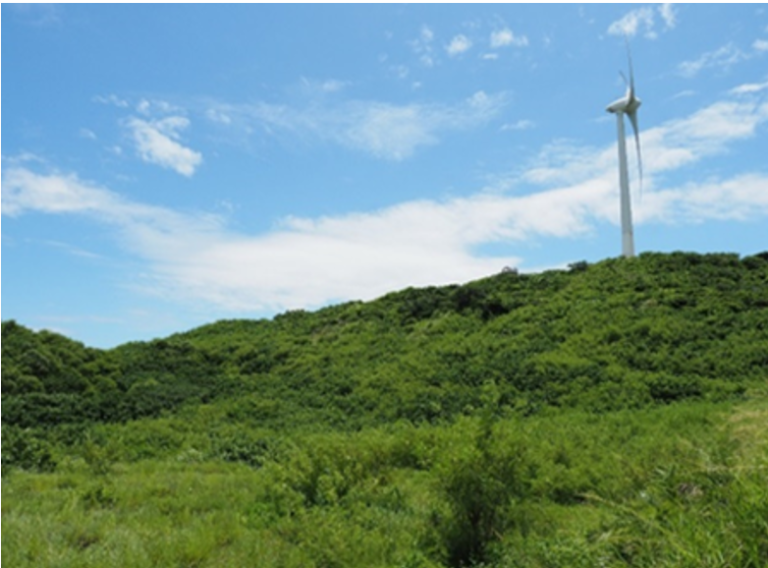
2. Transdisciplinary collaboration to promote the restoration of rare plants in the Sinpu grassland landscapes
In order to facilitate the restoration of rare plants in the Sinpu Grassland, the Taiwan Forestry Research Institute and Observer Ecological Consultant Co., Ltd. conducted a survey of rare plant species in the area. The survey identified several rare species, including Taiwan Wild Grape (Vitis thunbergii var. taiwaniana), Hairystyle Cherry (Prunus pogonostyla), Seashore Rose (Rosa bracteata), Matsumura’s Snow-bell (Styrax matsumuraei), Tatushanensis Clematis (Clematis chinensis var. tatushanensis), and Twisting Dregea (Dregea volubilis). These species have been included in the provenance list of the Green Network Project, making transplanting a feasible option. However, grafting small-leaved grapes and vines of the Clematis genus may prove to be more challenging, and thus obtaining cuttings for propagation is recommended.
Given the fragile nature of the trees after transplantation, professional care is necessary. As such, the Hsinchu Forest Office has established a nursery equipped with professional equipment and technology. It is recommended that trees be harvested from their current location and transported to the nursery, where they can be cared for over a period of 2-3 months until they have grown sufficiently. Once the trees are deemed healthy, they can then be moved to the Sinpu Elementary School for planting.
In order to promote the restoration of rare plant species in the Sinpu grassland landscape, there is a well-defined division of labor and cooperation between different regions, which is as follows:
- Taichung Branch Soil and Water Conservation Bureau: responsible for ecological monitoring and verification, rare plant transplantation, and preservation cooperation mechanism.
- Taiwan Forestry Research Institute: visiting Sinpu Elementary School to train teachers and students on plant transplantation methods, maintenance, and management methods; providing plant illustrations, including plant photos and habits, as teaching materials and plant manuals for Sinpu Elementary School.
- Hsinchu District Forest Office and Observer Ecological Consultant Co., Ltd.: responsible for conducting plant surveys, providing plant seedlings, and designing the rare plant restoration area of Sinpu Elementary School.
- Sinpu Elementary School: the principal, teachers, and students of Sinpu Elementary School will participate in plant transplantation methods, maintenance, and management training courses.
- Sinpu Community: responsible for conducting grassland ecological guide and commentator training and ecological education activities in Sinpu Community.
- Taiwan Landscape Environment Association and Environment and National Chung Hsing University: responsible for guiding the Sinpu community to formulate the Satoyama Initiative framework, assisting the community in obtaining funds from the Soil and Water Conservation Bureau, and promoting plant protection, ecological education, and ecological experience activities.
3. Promoting ecological checks for hillside projects to maintain grassland landscapes
During the period of 1980-1990, the environmental protection and ecological conservation awareness in Taiwan began to emerge. The public gradually became more concerned about various ecological issues caused by land development and engineering construction, leading to increased participation in policy-making and demands for information disclosure. In response to this, the SWCB actively developed an ecological inspection mechanism and implemented environmentally friendly measures to improve the environmental friendliness of soil and water conservation projects and reduce the negative impact of such projects on the environment and ecology. The Bureau also incorporated the “Watershed Friendly Environmental Ecology Database” application in the ecological inspection operation, which is connected to various domestic ecological databases to collect comprehensive and rich ecological data. This database helps engineering units to have early access to important ecological information and address public concerns regarding ecological issues”.
The ecological inspection mechanism integrates engineering and ecological concepts by conducting ecological investigations and assessments, establishing communication and consultation mechanisms, introducing ecological conservation strategies at each project stage, and integrating citizen participation and information disclosure into the work process. To fully record the ecological conservation and friendly measures evaluated and implemented at each stage of the project, as well as the discussion process with the ecological team and the public, different checklists are utilized. The mechanism aims to improve the environmental friendliness of Taiwan’s slope soil and water conservation projects, reduce their negative impact on the environment and ecology, adopt the principles of avoidance, reduction, mitigation, and compensation, and formulate eco-friendly strategies. Furthermore, the mechanism invites local people and non-governmental organizations to discuss and seek the best project plan. The SWCB actively incorporates the “Watershed Friendly Environmental Ecology Database” application in the ecological inspection operation, which connects to various domestic ecological databases to collect complete and rich ecological data. This step is beneficial for engineering units to obtain important ecological information and address concerns of the public.
The Water and Soil Conservation Bureau established the Watershed Friendly Environmental Ecology Database in 2017 and subsequently formulated a standard workbook for ecological inspection in 2018. The ecological inspection operating procedures are required to align with the project life cycle, including the review, design, construction, maintenance, and management stages. At the submission and deliberation stage, the ecological inspection mechanism is introduced to assess project benefits and possible ecological costs and to evaluate the necessity of project implementation. During the design stage, ecological issues and objects of ecological protection are evaluated, and eco-friendly countermeasures and measures are formulated after multi-party discussions.

The construction stage includes the “before construction” and “during construction” phases, during which ecologically friendly countermeasures and measures are implemented and managed through ecological monitoring, supervision, random inspection, or self-inspection to ensure the integrity of ecological functions and protection targets of the area. During the maintenance and management stage, the status of ecological restoration and the quality of ecological protection objects within the governance scope are tracked for a period of two to five years after project completion to verify the effectiveness of friendly measures and to implement rolling reviews.
4. OECMs: conservation strategies beyond protected areas
Other effective area-based conservation measures (OECMs) stand for distinct geographic regions beyond legally defined protected areas, in which local biodiversity and associated ecosystem functions and services are favorably and sustainably impacted by diverse governance and management strategies while embodying cultural, spiritual, socio-economic, and other culturally locally relevant values (CBD, 2018). Furthermore, it demonstrates implemented actions in the region that successfully achieve enduring and efficient on-site biodiversity conservation. From 2015 to 2018, the International Union for Conservation of Nature (IUCN) offered technical guidance on OECMs to the Convention on Biological Diversity (CBD) Parties through a World Commission on Protected Areas (WCPA) Task Force dedicated to OECMs. In 2018, the CBD Parties agreed on guiding principles, shared features, and criteria for identifying OECMs (CBD Decision 14/8). In alignment with the guiding principles, governments, relevant organizations, indigenous peoples, and local communities are encouraged to utilize the voluntary guidelines on OECMs. It will aid in identifying, acknowledging, and supporting OECMs and reporting OECM data to the World Database on OECMs (IUCN WCPA, n.d.).
Identifying OECMs presents a valuable chance to enhance recognition and support for long-lasting, effective conservation beyond designated protected areas. These conservation efforts are managed under various governance structures and carried out by various stakeholders, including indigenous peoples, local communities, private sector entities, and government agencies. To identify an OECM, here are several important conditions as follows:
- It is not a traditional protected area (e.g., a protected area by law) whose primary purpose is biodiversity conservation.
- Under proper ongoing management.
- Playing a critical role in in-situ biodiversity conservation.
- Furthermore, it conforms to the Satoyama Initiative’s core competence and can provide the ecosystem service’s functions and values.
The Sinpu grassland ecosystems (SGE) offer many benefits to humans derived from the natural environments and resources present. These benefits include supporting services such as providing habitats for flora and fauna, regulating services like natural succession after a fire, provisioning services through crop production, and cultural services like ecological and cultural education. Moreover, the SEPLs within the SGE play a vital role in conserving rare and valuable plants and protecting animals such as the leopard cat, peregrine falcon, collared scops owl, small Indian civet, and others. In theory, the most direct and quick approach to management could be the designation of legally protected areas. However, due to Taiwan’s mountainous terrain, flat land is scarce, and most of the population is concentrated in these narrow areas. Especially on the island’s western side, there are mosaic landscapes where human activities and natural environments are interwoven, and the undisturbed wilderness has either been developed or become fragmented. In rural SEPLs (e.g., SGE), a human-natural coupling environment, establishing protected areas may fulfill the need for ecological conservation. On the other hand, it could also directly or indirectly jeopardize the livelihoods and production rights of the locals.
Moreover, the stakes are significant, considering the legislative procedures, present political and economic tendencies, and prevailing local opinions. Designating protected areas for the SGE could require substantial effort and time. Therefore, in this case study, it is most appropriate to adapt the OECM approach and implement actions of the Satoyama Initiative. In particular, in-situ biodiversity and habitat conservation can be achieved based on the following practices, which are:
- Kick-offs and Implementation of the National Green Network and the Project for Future Green;
- Cross-sectoral collaboration for the restoration and conservation of rare and valuable plants with the SGE SEPL;
- Actively promoting the slope land ecological check for properly managing grass landscapes.
The practices above align with the primary expertise of the Satoyama Initiative and can deliver the functions and values of ecosystem services.
Results
1. A healthy grassland ecosystem allows rapid recovery of the ecosystem after fire
Based on the long-term monitoring and investigation conducted by the Taiwan Forestry Research Institute, the vegetation in the shallow mountain areas of Houlong and Tongxiao in Miaoli County, where fires are frequent, exhibit notable characteristics. Specifically, the plants demonstrate the ability to germinate from rhizomes, resulting in the production of new tillers. They also possess a longer flowering and fruiting period and are able to generate a significant quantity of seeds while accumulating dead leaves during dry seasons. These characteristics contribute to the production of highly flammable materials, which enhances their growth and dominance after being burned.
Among the species present in the area, the Taiwan Date Palm (Phoenix hanceana) exhibits helically-stacked, thick petiole bases that serve to protect the main stem and terminal bud growth point, allowing the plant to quickly recover from repeated fires. Similarly, woody species such as the Taiwan Acacia (Acacia confusa), Pikoktsai Bridelia (Bridelia tomentosa), Comphor Tree (Cinnamomum camphora), and Japanese Mallotus (Mallotus japonicus) regenerate new shoots from uninjured roots and stems after a fire. The Roxburgh Sumac (Rhus javanica var. roxburghiana) uses underground roots to rapidly produce new shoots, leading to its successful recovery after a fire.
Finally, the Gramineae millet species exhibits the ability to quickly regenerate from underground rhizomes, possess a longer flowering and fruiting period, and can accumulate a significant number of dead leaves during dry seasons. These traits lead to the production of highly flammable materials, which promote the species’ dominance in the local ecosystem after a fire.
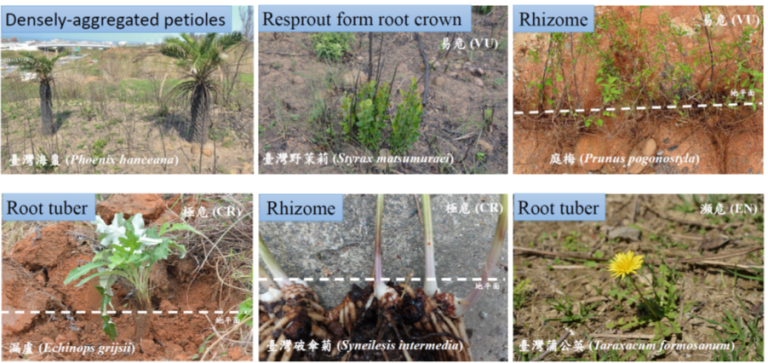
The above observations indicate that plants growing in shallow mountain areas prone to frequent fires have evolved and adapted over time, selecting suitable traits that enable them to survive in this disturbed habitat and exhibit a certain degree of resistance. However, the frequency and intensity of fires can also have a significant impact on the species composition and diversity in the area. In particular, high-intensity and frequent fire disturbances can disrupt and degenerate the growth of forest trees, leading to changes in the vegetation composition. For instance, the forest vegetation in the vicinity of Houlong Township, which is dominated by acacia trees, may rapidly degenerate into a grassland primarily composed of millet under the influence of such disturbances.
However, small fire disturbances that occur with a moderate frequency and range can contribute to maintaining a mosaic landscape where forests and grasses coexist, which in turn provides habitat space for plants with strong light requirements and increases species diversity. A survey conducted by the Taiwan Forestry Research Institute revealed that the mountainous area of Houlong in Miaoli County has a high diversity of plant species, including many rare plants that have disappeared in other areas. These plants have adapted to the disturbed habitat and have good growth and regeneration conditions. Some of these species include the Chinese Fringetree (Chionanthus retusus), Hairy-style Cherry (Prunus pogonostyla), Matsumura’s Snow-bell (Styrax matsumuraei), East China Globethistle (Echinops grilisii), Syneilesis intermedia, Dendranthema lavandulifolium var. tomentellum, Shimadae Aster (Aster shimadae), Eragrostis nevinii, Semialata (Alloteropsis semialata), Blackend Swallowwort (Cynanchum atratum), Shiningleaf Millettia (Callerya nitida), and others.
In recent years, ecological research has increasingly recognized the impact of human disturbances on the natural environment and has sought to quantify their effects. Efforts have been made to explore the balance between human activities and biological diversity, recognizing the importance of harmony between the two. The frequent and severe fires in shallow mountain areas pose risks to both the safety of local residents and the environment. For security and economic reasons, measures are being taken to eliminate fire interference. However, the removal of this important disturbance may reduce suitable habitat for rare plant species, thereby affecting species diversity. Ongoing survey and monitoring of the site aim to understand the relationship between fire disturbance frequency and intensity, local vegetation restoration, and species diversity. It is hoped that future results can provide suggestions for local environmental and ecological management, balancing the safety of the public and the preservation of special features. A win-win strategy for rare plant diversity. Monitoring of vegetation recovery one year after fire disturbance shows a landscape adorned with woody and herbaceous plants, including millet, miscanthus, and other gramineous plants, as shown in the accompanying photo.
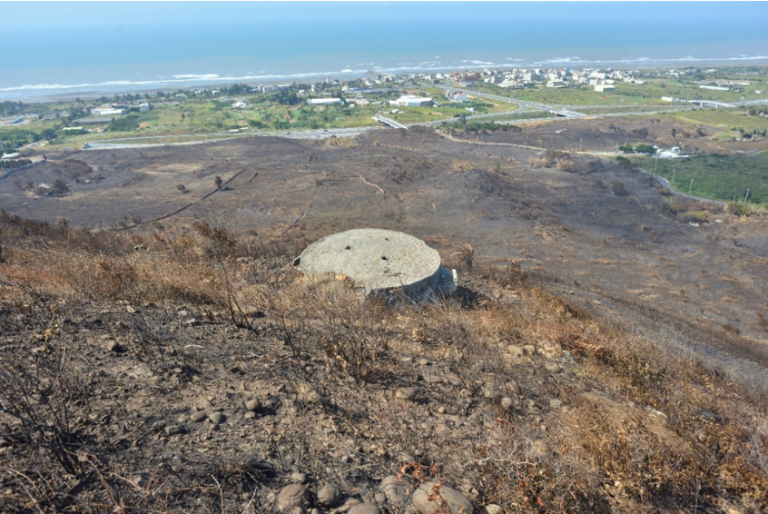
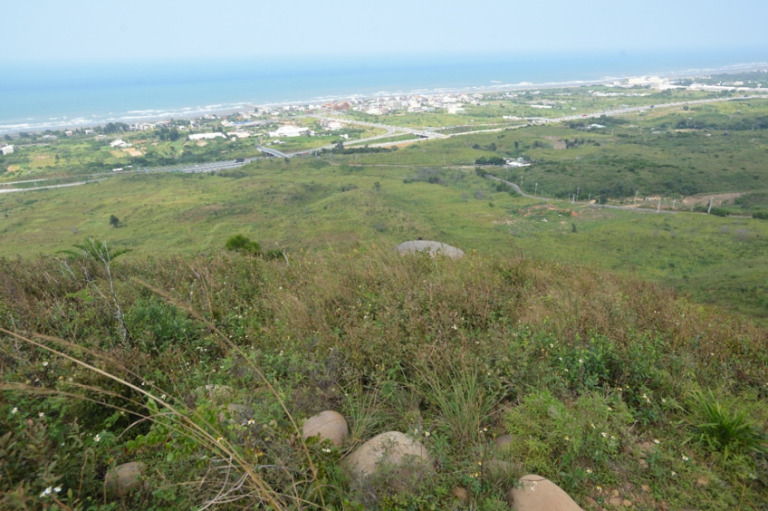
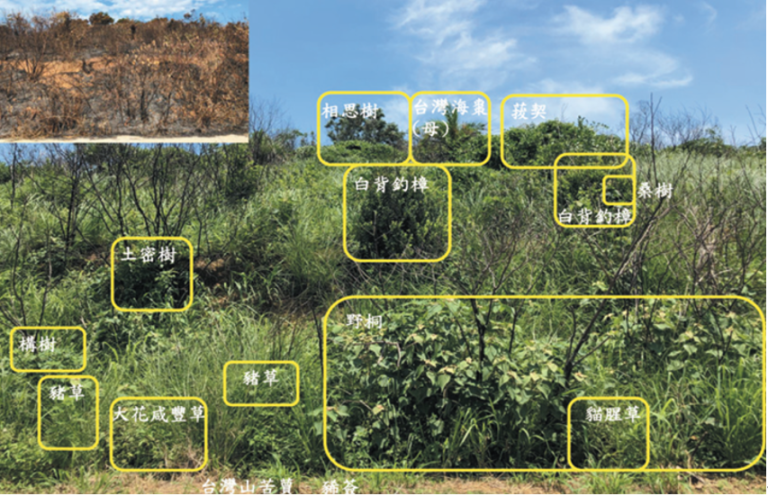
2. Grassland ecosystems: fostering a multifaceted biological habitat
The project’s data on mammals, birds, and reptiles is sourced from the “Taiwan Terrestrial Vertebrate Distribution Inspection Data Collection” (Endemic Species Research Institute, 2022), which was mapped by the same institute using an ArcGIS project record file. The relevant settings of the ArcGIS project, such as superimposed layers, were taken into consideration, as well as the bird’s activity ability and conservation category, which includes I (Endangered species), II (Rare and valuable species), and III (Other conservation-deserving species). The observation data of Taiwan’s endemic bird species within a 2-kilometer buffer zone in Sinpu, Tongxiao Township, and the observation data of mammals and terrestrial reptiles within the range of Sinpu were obtained from the Taiwan Roadkill Observation Network. An ecological assessment by the Taichung Branch SWCB on August 11, 2020, revealed the presence of endangered species of protected wild animals, including Leopard cat and Peregrine falcon, as well as category II rare and valuable species such as Chinese sparrowhawk, Black-winged kite, Crested honey buzzard, Crested goshawk, Grey-faced buzzard, Crested serpent eagle, Collared scops owl, and Civet. Other conservation-deserving species in category III include Taiwan partridge, Brown shrike, and Oriental pratincole.
The Grey-faced Buzzard is a migratory raptor species, as reported by the Raptor Research Group of Taiwan. Its breeding range is located in Ussuri, southeastern Siberia, Northeast China to Hebei, the Korean Peninsula, and the Japanese archipelago; and its wintering range extends to Southeast Asia. During autumn, the cold weather in the north results in a scarcity of food, which triggers migration to warmer areas in the south for the winter. These wintering areas include the southern part of the Ryukyu Islands, Taiwan, the Philippines, Indonesia, and the southern part of the Indochina Peninsula. Taiwan is one of the most critical stopover sites for Grey-faced Buzzards along their migratory route. According to the State of Taiwan’s Birds 2020 (Lin & Pursner 2020), on average, about 50,000 individuals use the Kenting National Park as a stopover site every October. This migration event is referred to as the “Great Migration” of migratory raptors, and thousands of birders and tourists flock to the south most point of Taiwan to observe them.
During the spring migratory season, flocks of Grey-faced Buzzards move northward along the western coast of Taiwan. The grassland landscapes in this area provide excellent stopover sites for Grey-faced Buzzards and other raptor species. The eBird system shows that this site has accumulated 122 bird species, including 18 raptor species. In addition to Grey-faced Buzzards, the grasslands are also habitat for Eastern Buzzards (Buteo japonicus), Black Kites (Milvus migrans), and Eastern Marsh Harriers (Circus spilonotus), which are known as keystone species in a given ecosystem. Thus, the grasslands support high diversity and abundance of wildlife, which is an essential ecosystem function.
As such, the conservation of these grasslands and other important habitats is crucial for the Grey-faced Buzzard and other bird species. Continuous monitoring of these populations is necessary to ensure their protection and the maintenance of their habitat quality. Moreover, public education and outreach programs can help raise awareness about the importance of conserving these species and their habitats.

3. The restoration of rare plants in Sinpu Elementary School
The protection measures for sensitive species on the mountaintop in Sinpu District are implemented through a staged approach. Firstly, the plants are transplanted to the flower garden of the Hsinchu Forest District Office and the whole process is recorded through video recording. Secondly, Sinpu Elementary School and the community participate in environmental education activities at the nursery. Lastly, take-home activities are provided for growing rare plants.
- The Hsinchu Forest District Office, Forestry Bureau Council of Agriculture, Taichung Branch SWCB, and other relevant stakeholders conducted on-site surveys to assess the personnel required for transplantation and the time needed for transplantation.
- Rare plants such as Taiwan Wild Grape, Hairystyle Cherry, Seashore Rose, Matsumura’s Snow-bell, Tatushanensis Clematis chinensis Osbeck, and Twisting Dregea have been included in the provenance list of the Green Network Project. While transplanting is not an issue, small-leaved grapes and Clematis genus climbing vines are more difficult to transplant. Branches can be taken for propagation and the rest of the plants can be evaluated according to the on-site situation.
- Because the plants are fragile after transplantation, they require care by professional units. The Hsinchu Forest District Office has established a satellite base with a nursery field equipped with professional technology and equipment. The plants are kept in good growth condition for a month, and it is appropriate to move them back to the local Sinpu Elementary School and other fields.
- The transplanting process needs to be low-key as there is a chance of death, and local students can participate in environmental education activities such as plant-related ecological education after transplantation.
- The forestry laboratory collects seeds during autumn and winter, grows the seeds in spring, and plants the seedlings in large quantities in the Houlong Restoration Park. A few remaining seedlings are available for trial planting, including about 10 shrubs and herbs, and Lavandulaeleaf Dendranthema. The categories need to be inventoried and sorted out. If the future plan continues, the Taiwan Forestry Research Institute will discuss the list of possible plant combinations for seed collection.
- It is possible to create a file introducing Hokkien teaching and have local elders read and record it phonetically. Two records of Sinpu accent and general tone can be used as teaching materials for plant explanations in Hokkien.
- After the rare plants are planted in the school in the future, students can study in the nearby school and directly identify the plants when they go to Lingding to teach outside the school. The forestry laboratory can draw up a list of rare plants and dominant species on the mountaintop, which can be used in conjunction with community operations to educate the community.
- Sinpu Elementary School has implemented plant identification education, marine education, biology education, and reading education. Lingding ecological workshops will also be held in the future. Other schools will also be provided as off-campus teaching fields for small groups of about 10 people, and group teaching will be conducted.
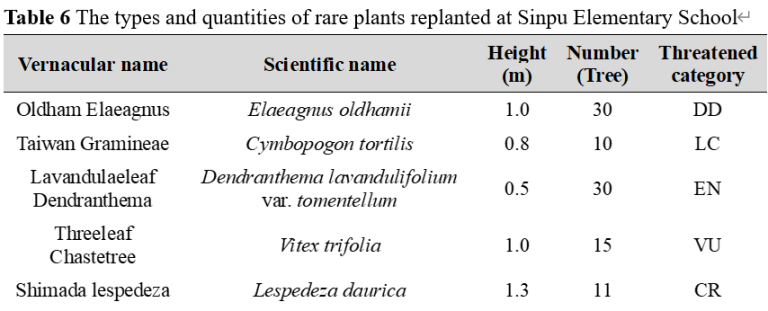
4. Promoting ecological education of rare grassland plants in elementary school
In 2021, a collaborative effort was initiated between Sinpu Elementary School and Taiwan Forest Recreation to conduct ecological courses in Sinpu Grassland in Hokkien, with a focus on creating a file of Hokkien’s teaching introduction. The local elders were invited to read and record the pronunciation and shape of the words in both Sinpu accent and general accent, which were used as teaching materials for plant explanations in Hokkien.
Once the rare plants are planted in the school, students can study in the nearby school and identify the plants directly when they go to Lingding to teach outside the school. The forestry laboratory can create a list of rare plants and dominant species on the top of the ridge, which can be used in conjunction with community operations to enhance the knowledge of people in the community. This approach can enable everyone from students to residents to have a deeper understanding of plants.
Sinpu Elementary School currently implements plant identification, marine, biology, and reading education. The school plans to hold Lingding ecological workshops and provide other schools with off-campus teaching venues in the future. These workshops will be conducted in small groups of about 10 people and grouped into modular teaching.

A planting initiative was undertaken on March 30th within the flower garden of Sinpu Elementary School. The planting scheme was designed to establish a multi-layered configuration that would address the issue of spiny Euphorbia hirta, achieved by the planting of Lespedeza daurica (CR) and Vitex trifolia (VU). Furthermore, numerous rare plant species were introduced, including Syneilesis intermedia (CR), Prunus pogonostyla (VU), Cynanchum atratum (EN), Echinops grijsii (CR), Cirium lineare (EN), Dendranthema lavandulifolium var. tomentellum (EN), Aster shimadai (VU), Eragrostis nevinii (CR), Sporobolus hancei (VU), and Carex laticeps (EN).
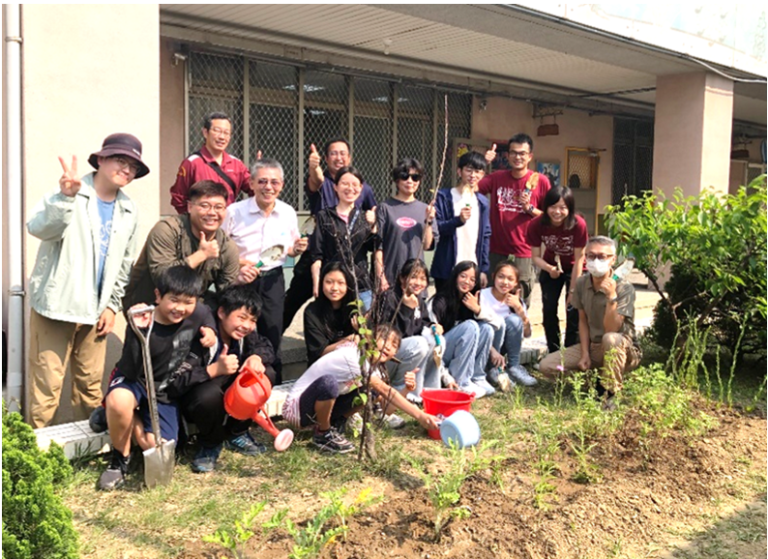
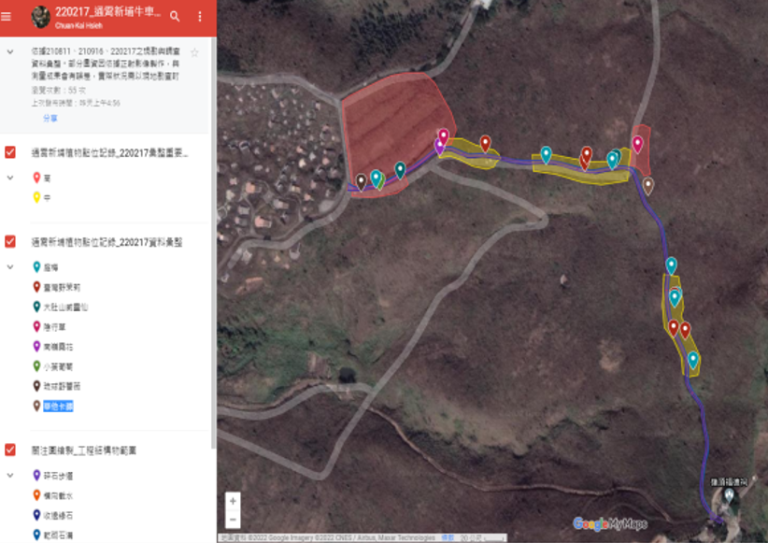
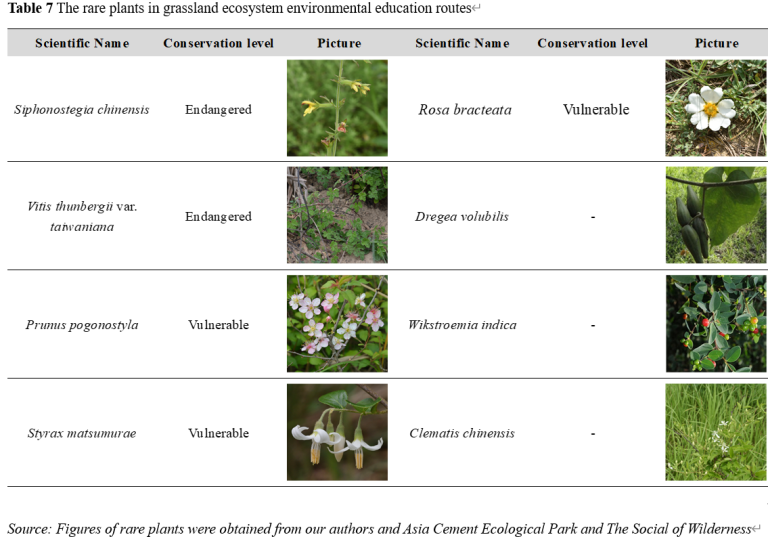
5. The SWCB’s ecological inspection promotes public participation in environmentally friendly projects
The “Soil and Water Conservation Engineering Ecological Inspection Information Zone” shows that from 2020 to 2022, there were 692, 837, and 752 slope engineering cases for ecological engineering inspections, respectively. The number of site survey and discussion meetings increased overall, with 26, 172, and 111 in each year, respectively.
According to the watershed-friendly environmental ecological database of the Bureau of Water and Soil Conservation, Sinpu Community’s grassland landscape is a first-level ecological inspection area. This area belongs to a special and important native grassland with unique native plants and environmental pressure that restricts forest development. Maintaining the state of the grassland year-round provides easy access to rare plants such as Tatushanensis Clematis, Matsumura’s Snow-bell, Hairystyle Cherry, and other rare plant species, as well as Leopard cats, Civets, and migratory raptors.
During project implementation, the following principles should be followed:
- The ecological team should confirm the location and identification characteristics of rare plants before construction. If construction cannot avoid these plants, they should be transplanted to other appropriate locations, or the plants should be temporarily relocated and replanted after the project is completed.
- The project should be limited to the existing disturbed or exposed area, avoiding the surrounding grassland to preserve the original grassland. Walkways can be constructed using hand or other flexible methods without cement to reduce the impact of the project on the grassy land.
- The on-site flora is rich, and the plant resources should be adequately preserved, utilized, and restored. There is also a variety of traditional plant utilization knowledge that can be used as explanations or local educational materials.
- The impact of operational disturbances, engineering dimensions, and construction methods on ecological resources must be carefully assessed during project planning to avoid fires caused by engineering operations and damage to the habitats of native plants and wild animals. By adhering to these principles, the Bureau aims to ensure the preservation of the native grassland and its ecosystem.
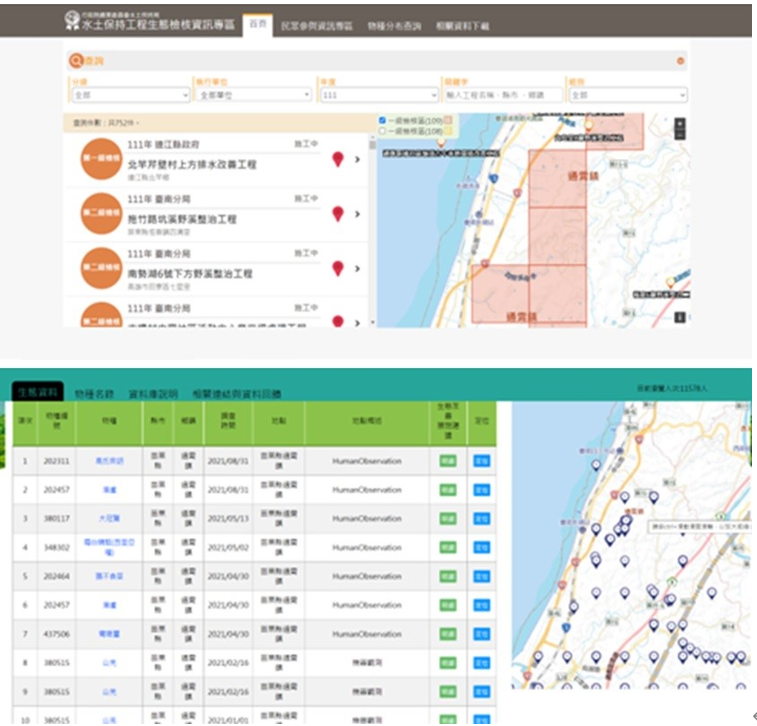
Lessons learned
The region experiences the start of its dry season in October. During this time, the northeast monsoon brings in dry and cold winds that blow through the mountains, causing the shedding of leaves among the shrubs and herbs, as they prepare to dominate and survive through the winter. Tomb Sweeping Day, which usually takes place after Chinese New Year (from January to February), marks the final stage of the dry season. In this region, the locals resort to using fire to burn the weeds on tombs, often leading to accidental wildfire outbreaks. Fortunately, these fires tend to occur during the period when most plants are in dormancy, and only have a minor impact on annual or deciduous shrub plants. However, trees, especially the aggressive Acacia confusa species with nitrogen fixation ability, are severely damaged by these fires. When the plum rain season commences in March, which brings with it generous rains, the vegetation resprouts and thrives immediately, helping the region recover from the impact of wildfires.
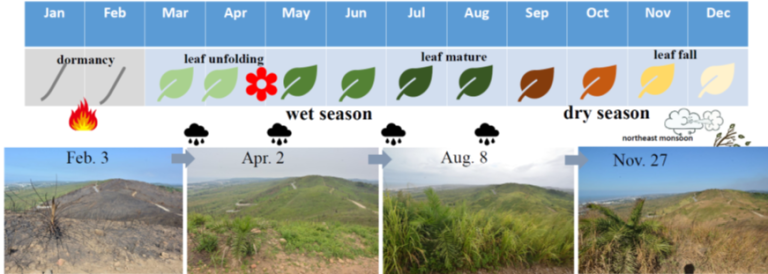
Key messages
- Taiwan’s terrain is characterized by high mountains and island landscapes, and the grassland scenery of the coastal hills on the west side of Miaoli County holds a significant position in Taiwan’s plant ecology.
- Grasslands are often interspersed with farmland and residential areas, and human activities frequently cause severe disruptions to the grassland landscape, resulting in the loss of a substantial portion of vegetation. Nonetheless, some plants have developed adaptive traits such as fire-resistant roots, stems, and seeds, which allow for sustained survival and propagation.
- The ecological assessment procedures of the SWCB can regulate the impact of developmental activities on grassland landscapes while adopting eco-friendly methodologies to mitigate engineering impacts on the landscape and maintain the integrity of ecologically vulnerable regions.
- Through the cultivation of conservation intelligence in communities and schools in rural regeneration efforts and the establishment of transdisciplinary collaborative platforms, rare and endangered plants can be safeguarded through plant restoration and environmental education approaches, all while achieving sustainable preservation of traditional languages.
References
- Asia Cement Ecological Park (2020). Plant. Retrieved March 25, 2023, from https://accpark.org
- CBD (2018). Decision adopted by the conference of the parties to the convention on biological diversity. Retrieved March 25, 2023, from https://www.cbd.int/doc/decisions/cop-14/cop-14-dec-08-en.pdf
- Central Weather Bureau (CWB) Observation Data Inquire System (2021). Long-term rainfall trends. Retrieved March 25, 2023, from https://e-service.cwb.gov.tw/HistoryDataQuery
- Forest Fire Disaster Potential Database Information System (2011). Forest Service: The Proportion of Causes of Forest Fires. Retrieved March 25, 2023, from https://forecast.forest.gov.tw/Forecast
- IUCN WCPA (n.d.). IUCN WCPA Other Effective Area-based Conservation Measures Specialist Group. Retrieved March 25, 2023, from https://www.iucn.org/our-union/commissions/group/iucn-wcpa-other-effective-area-based-conservation-measures-specialist
- Observer Ecological Consultant Co., Ltd. (2022). Media reports. Retrieved March 25, 2023, from http://www.observer.com.tw
- Raptor Research Group of Taiwan (2017). Raptor List of Taiwan Retrieved March 25, 2023, from https://raptor.org.tw/raptor-research/taiwan-journal-of-raptor-research.html#
- Soil and Water Conservation Bureau (2019). Annual Report. Retrieved March 25, 2023, from https://www.swcb.gov.tw/Home/eng/Info/item_list?mid=391
- Taiwan Forestry Research Institute (2022). Research. Retrieved March 25, 2023, from https://www.tfri.gov.tw/en/cl.aspx?n=7564
- The Social of Wilderness (2020). Event news. Retrieved March 25, 2023, from https://www.sow.org.tw

